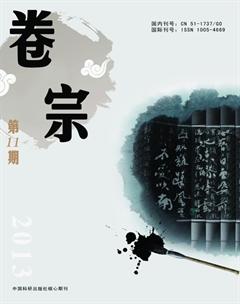Analysis of Ironies in Balzac and the Little Chinese Seamstress
Abstract: Irony is a common linguistic device in linguistics and literature by which a listener or reader can understand more than what a speaker or a writer expresses. An ironic utterance conversationally implicates the opposite of what it literally says. Balzac and the Little Chinese Seamstress is considered as a known book that includes the skillful use of ironies. And this paper tries to analyze the very examples of the use of ironies in the book Balzac and the Little Chinese Seamstress. And the author hopes that through the analysis, readers can better understand the use of irony in literature and the book Balzac and the Little Chinese Seamstress.
Key words: irony; Balzac and the Little Chinese Seamstress; linguistic device; literature
Introduction
The past ten years has witnessed a comeback of scholars frenzy about world literature. Some great books such as Azar Nafisis memoir “Reading Lolita in Tehran” and in Dai Sijies novel “Balzac and the Little Chinese Seamstress” sell extremely well, indicative of the fact that scholars have been awakened to the influence of world literature as regards their meaning and value. As far as Dai Sijies novel “Balzac and the Little Chinese Seamstress” is concerned, its expert use of irony has added an icing to this beautiful literary cake. As such, irony is a very vital theme of pragmatics, which is viewed by Paul H. Grice (1975) “as a case of conversational implicature triggered by a blatant flouting of the maxim of quality” (Hirsch,2011). According to Grices Cooperative Principle, speakers tend to make their contribution to a conversation “such as is required, at the stage at which it occurs, by the accepted purpose or direction of the talk exchange” (Grice 1975: 26)
In order to explore the ironies existing in the book — Balzac and the Little Chinese Seamstress, firstly we are supposed to know what “irony” is. Irony is one of the most important literary devices preferred by majority of literary figures. It is the use of words whose actual meanings are contradictory to the words themselves so as to achieve a sarcastic and amusing effect. In the book Balzac and the Little Chinese Seamstress, ironies were repeatedly used by the author from the beginning to the end. This paper will mainly select three typical ironies and make a brief analysis.
In the very beginning of the book, the chapter named “Mozart is thinking of Mao” includes a quite ironic scene. Luo played a music written by Mozart in front of the village head. At that particular time when western culture including music was prohibited by Chairman Mao in China, playing western music was forbidden, and things associated with Chairman Mao were held in esteem, the narrator responded with wisdom “Mozart is thinking of Mao” to answer the question of the villager head on the name of the music,. In this way, both Luo and the narrator successfully avoided serious political punishment. However, the fact is that Mozart had been dead even before the birth of Chairman Mao, so the sentence “Mozart is thinking of Mao” is very ridiculous, and indicates that during the Great Cultural Revolution, people were rather blind-sighted to follow Chairman Mao.
The second irony is that the protagonist Luo who resents his fate of being sent to mountain to be reeducated by the central government, at the same time, tries to reeducate the Chinese seamstress. The book Balzac and the Little Chinese Seamstress narrates two young people—the narrator and his friend Luo—are sent to the mountain to receive reeducation. Both of them have experienced grim country life “没有任何公路通达那里,只有一条窄窄的羊肠小道”(第6页)。The two young people, like most other young people who are sent to remote country to be reeducated, are resentful for the decision from the then central government. Here comes a prime irony that although Luo resents being educated, he himself intended to reeducate his lover—Chinese seamstress. “With these books I shall transform the Little Seamstress. Shell never be a simple mountain girl again” (P100).
The third irony is that the aim of reeducation recommended by Chairman Mao is to deprive the bourgeois ideas of Chinese people, but the fact goes to the opposite direction that people become more closer and accessible to the bourgeois ideologies. Both of the young men, after being sent to mountain to lead a grim life, became fascinated about the suitcase of books of “four eyes”. This fame drives them to steal the books. By reading, the narrator began to appreciate the splendor of individualism advocated by the bourgeois society. “但是,《约翰·克里斯朵夫》对我来说,以它那热情洋溢的却又不带任何狭窄心胸的个人主义,成为了一种生命的启示。没有它,我可能永远也不会明白个人主义中所包含的那种精彩与辉煌” (第48页). Therefore, this constitutes another irony.
Conclusion
According to Littman and Mey (1991),“humor and irony are intimately related. […] While we do not believe that all irony is humorous, we do believe that our approach to irony might suggest a useful methodology for studying also other kinds of humor (Littman and Mey 1991: 149).Irony and humor are interconnected closely, but they come in their special features. Irony is more pragmatically employed and humor is verbally employed only for the sake of being humorous. By using ironies, the narrator of this book has successfully exposed the Chinese society in the phase of Great Cultural Revolution and satirized the negative phenomena during that period.
References
[1]Dai, S. (2002). Balzac and the little Chinese seamstress / Dai Sijie ; translated from the French by Ina Rilke. New York : Anchor Books, 2002.
[2]Grice, H.P.(1975). “Logic and conversation”. In P. Cole and J.L. Morgan (eds), Syntax and Semantics,Vol. 3: Speech Acts. New York: Academic Press, 41-58.
[3]Hirsch, Galia. “Between Irony And Humor: A Pragmatic Model.” Pragmatics & Cognition 19.3 (2011): 530-561. Communication & Mass Media Complete. Web. 15 Nov. 2013.
[4]戴思杰, 余中先, & 子晓. (2003).巴尔扎克与中国小裁缝. 北京十月文艺出版社.
作者简介
刘庆(1988—),女,安徽潜山县人,四川外国语大学研究生院2011级英语语言文学专业,硕士研究生,研究方向:英语语言理论与应用。
——《复活(节选)》中的人性理想寻找

